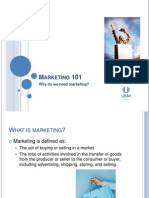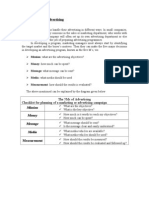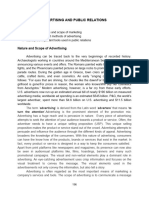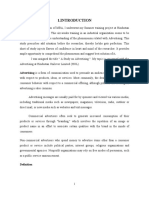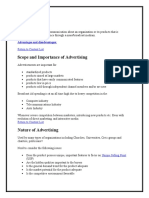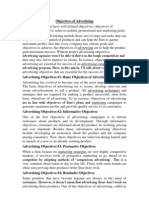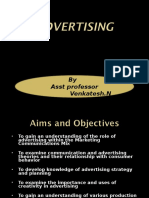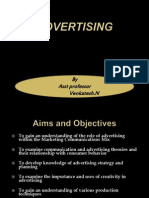0 ratings0% found this document useful (0 votes)
251 viewsLecture 1 - Sem 2
Lecture 1 - Sem 2
Uploaded by
Barbu FlorinAdvertising adds value to brands by influencing consumer perception. Effective advertising causes brands to be viewed as more elegant, prestigious, and of higher quality. Red Bull sponsors extreme sports events to target young adults and passes out free samples from a promotional vehicle. Their strategy is to alter consumer perception and associate the brand with an adventurous lifestyle.
Copyright:
© All Rights Reserved
Available Formats
Download as PDF, TXT or read online from Scribd
Lecture 1 - Sem 2
Lecture 1 - Sem 2
Uploaded by
Barbu Florin0 ratings0% found this document useful (0 votes)
251 views52 pagesAdvertising adds value to brands by influencing consumer perception. Effective advertising causes brands to be viewed as more elegant, prestigious, and of higher quality. Red Bull sponsors extreme sports events to target young adults and passes out free samples from a promotional vehicle. Their strategy is to alter consumer perception and associate the brand with an adventurous lifestyle.
Original Description:
english
Original Title
Lecture 1_sem 2
Copyright
© © All Rights Reserved
Available Formats
PDF, TXT or read online from Scribd
Share this document
Did you find this document useful?
Is this content inappropriate?
Advertising adds value to brands by influencing consumer perception. Effective advertising causes brands to be viewed as more elegant, prestigious, and of higher quality. Red Bull sponsors extreme sports events to target young adults and passes out free samples from a promotional vehicle. Their strategy is to alter consumer perception and associate the brand with an adventurous lifestyle.
Copyright:
© All Rights Reserved
Available Formats
Download as PDF, TXT or read online from Scribd
Download as pdf or txt
0 ratings0% found this document useful (0 votes)
251 views52 pagesLecture 1 - Sem 2
Lecture 1 - Sem 2
Uploaded by
Barbu FlorinAdvertising adds value to brands by influencing consumer perception. Effective advertising causes brands to be viewed as more elegant, prestigious, and of higher quality. Red Bull sponsors extreme sports events to target young adults and passes out free samples from a promotional vehicle. Their strategy is to alter consumer perception and associate the brand with an adventurous lifestyle.
Copyright:
© All Rights Reserved
Available Formats
Download as PDF, TXT or read online from Scribd
Download as pdf or txt
You are on page 1of 52
Business Communication
Advertising is non-personal communication that is paid
for by an identified sponsor, and involves either mass
communication via newspapers, radio, TV and other
media (e.g., billboards, bus stop signage) or direct-to-
consumer communication via direct mail.
There are 3 basic ways by which companies can add
value to their offerings:
by innovating
by improving quality
by altering consumer perception
Making the product available only at selected in places
where young adults like to party.
They also make use of consumer educators, who drive
around in a silver, Red Bull off-road vehicle, passing out free
samples who anyone who looks like they need a boost of
energy.
They sponsor extreme sporting events: snowboarding,
skateboarding, mountain biking.
Advertising adds value to brands by influencing consumer
perception. Effective advertising causes brands to be
viewed as more elegant, more stylish, more prestigious,
perhaps superior to competitive offerings, and in general, of
higher quality.
In the USA advertising is also perceived as an investment.
That is why in 2010, just before the 2
nd
wave of the
economic crisis, US companies invested approximately
$250billion on advertising. The biggest advertising
spenders, besides the USA, are Japan, Germany, the United
Kingdom, France and Canada.
The advertising process for a particular brand can be
understood as a development and implementation of an
advertising strategy, which has 4 major activities:
setting the objectives
budgeting, positioning, planning message strategy
developing media strategy
assessing advertising effectiveness.
The logic and planning
behind the ad
Advertisers develop ads to
meet objectives
Advertisers direct ads to
identified audiences
Advertisers create messages
that speak to the audiences
concerns
Advertisers run ads in the
most effective media
Strategy
Creative idea
Execution
Media
Strategy
Creative
idea
Execution
Media
The central idea
that grabs the
consumers
attention.
Creativity drives
the entire field of
advertising.
Strategy
Creative
idea
Execution
Media
Effective ads adhere
to the highest
production values in
the industry.
Clients demand the
best production the
budget allows.
Strategy
Creative idea
Execution
Media
Communication
channels that reach a
broad audience.
How to deliver the
message is just as
important as coming
up with the creative
idea of the message.
Marketing
Communication
Economic
Societal
The process a
business uses to
satisfy consumer
needs by providing
goods and services
Product category
Target market
Marketing mix
Brand
Marketing
Communication
Economic
Societal
Can reach a mass
audience
Introduces products
Explains important
changes
Reminds and
reinforces
Persuades
Marketing
Communication
Economic
Societal
Moves from being
informational to
creating demand
Advertising is an
objective means for
providing price-
value information,
thereby creating a
more rational
economy
Marketing
Communication
Economic
Societal
Informs consumers
about innovations
and issues
Mirrors fashion and
design trends
Teaches consumers
about new products
Helps shape
consumer self-image
Perpetuates self-
expression
There are 3 major reasons for setting advertising objectives:
1. The process of setting objectives literally forces top
marketing and advertising management to agree on the
course advertising is to take for the following planning
period, as well as the tasks it is intended to accomplish for a
brand.
2. Objective setting guides the budgeting, message creation,
and media selection aspects of advertising strategy.
3. Advertising objectives provide standards against which
results can be measured.
If too little money is spent on advertising, sales volume
will not be as high as it could be, and profits will be
reduced.
Companies set objectives by using judgment,
applying experience with similar situations or using
simple rules of heuristics. Among the heuristics we can
mention: percentage-of-sale method, and objective-
and-task method.
Percentage-of-sale method involves allocating a fixed
percentage of past or anticipated sales revenues to
advertising. For example, a company may allocate 5%
of the next fiscal periods anticipated sales on
advertising. If sales are estimated to $100 million for
the upcoming year, the advertising budget will be
$5million.
The objective-and-task method involves the following
3 step procedure:
Specifying the objectives that a particular
advertisement or entire ad campaign is intended to
accomplish
Identifying the specific tasks that must be
accomplished in order to reach those objectives
Accumulating anticipated costs to achieve the specific
task.
The outcome of this process should be enough to
achieve critical objectives.
Builds awareness of products and brands
Creates a brand image
Provides product and brand information
Persuades people
Provides incentives to take action
Provides brand reminders
Reinforces past purchases and brand
experiences
Advertiser
(client)
Agency
Media
Supplier
Audience
Uses advertising to
send out a message
about its products
Initiates the
advertising effort by
identifying a
marketing problem
Approves audience,
plan and budget
Hires the advertising
agency
Advertiser
(client)
Agency
Media
Supplier
Audience
Has strategic and
creative expertise,
media knowledge,
workforce talent, and
negotiating abilities
Advertising
department
In-house agency
Advertiser
(client)
Agency
Media
Supplier
Audience
The channels of
communication that carry
the message to the audience
Are also companies or huge
conglomerates
Mass media advertising can
be cost effective because
the costs are spread over
the large number of people
the ad reaches.
Advertiser
(client)
Agency
Media
Supplier
Audience
Assist advertisers,
agencies, and the
media in creating
and placing the
ads
Vendor services
are often cheaper
than those in-
house
Advertiser
(client)
Agency
Media
Supplier
Audience
The desired audience for the
advertising message
Data-gathering technology
improves accuracy of
information about customers
Advertisers must recognize
the various target audiences
they are talking to and know
as much about them as
possible
Brand advertising
Retail or Local advertising
Direct-Response advertising
Business-to-Business advertising
Institutional advertising
Nonprofit advertising
Public Service advertising
Brand managers work with the advertising agencies to
formulate specific meanings for their brands. This
positioning also establishes how the brand is to be
thought of by members of the target market and how
the brand is to be perceived relative to competitive
brands in the product category.
Absolut Vodka has built a reputation for being
cosmopolitan, Nike, considered the brand for serious
athletes, while Belgian chocolates are quality sweets.
1. If it creates an impression for a product
or brand.
2. If it influences people to respond in
some way.
3. If it separates the product or brand from
the competition in the mind of the
consumer.
Advertisers use a vast array of techniques to present
their brands in the most favorable light and persuade
customers to contemplate purchasing their brands.
Frequently employed techniques include:
Informational ads
(such as automobile ads in the
classified pages of a newspaper)
Taste the Rainbow (?)
Two for me none for you (?)
Have a break, have a Kit Kat (?)
Probably the best beer in the world(?)
Unlike any other (?)
Im lovin it (?)
Have it your way (?)
Sense and simplicity (?)
Ideas for life (?)
Inspire the World, Create the Future
(?)
Most recommended toothpaste for
sensitive teeth (?)
Number 1 recommended by dentists (?)
Three in one protection for your family
(?)
Hungry? Grab a Snickers (?)
Only smarties have the answer (?)
A Mars a day helps you work, rest and
play (?)
The Ultimate Driving Machine (?)
Great Taste, Zero Sugar (?)
Humorous executions (e.g. most Budweiser ads; Holiday
Inns advertising campaign with the thirty-something
slacker who lives at home with his parents and
grandmother).
Sex appeal (Emporio Armani fragrance ads) and
Celebrity endorsements (e.g. McDonalds
advertisement featuring Kobe Bryant)
1. I t extends from sound marketing strategy. Advertising
can be effective only if it is compatible with other
elements of the Integrated Marketing Communication.
2. It takes the consumers view. Consumers buy product
benefits, not attributes. Therefore, advertising must be
stated in a way that relates to the consumer needs,
wants, and values and not strictly in terms of product
characteristics
3. I t is persuasive. Persuasion usually occurs when there
is a benefit for the consumer, and not just for the
marketer.
4. I t finds a unique way to break through competitive
clutter. Advertisers continuously compete with each
other in order to catch consumers attention. This is not
easy if we take into consideration the massive number
of print advertisements, broadcast commercials, and
other sources of information available daily to
consumers.
Indeed, the situation in television advertising has been
characterized as audiovisual wallpaper, which implies
sarcastically that consumers pay just about as much
attention to commercials as they do to the detail in their
own wallpaper after it has been on the walls for a
certain period of time.
I t never promises more than it can deliver. This point
speaks for itself, both in terms of ethics and in terms of
smart business sense. Consumers learn quickly when
they have been deceived and resent it.
I t prevents the creative idea from overwhelming the
strategy. The purpose of advertising is to persuade and
influence; the purpose is not to be cute for cutes sake
or humorous for humors sake. The ineffective use of
humour results in people remembering the humor but
forgetting the selling message.
Effective advertising is usually creative. It
differentiates itself from the mass of advertisements,
and it is easier to give examples of creative
advertisements than to define them.
1. The Intel Inside application of ingredient branding
whereby this chip manufacturer convinced many
computer purchasers that Intel chips substantially
enhanced computer quality.
2. Absolut vodkas continuing magazine campaign that
focuses on this brands hip image by portraying the
brands unique bottle shape in trendy situations.
3. The milk moustache campaign that associates drinking
milk with a wide variety of interesting and respectable
celebrities.
Advertising message should be delivered to the right
customers at the right time, and with sufficient
frequency. As a result, advertising messages stand a
chance of being effective only if the media strategy
is effective.
Creative advertisement is more effective when placed
in media whose characteristics enhance the value of the
advertising message and reach the customer.
Besides determining which media to use (television,
radio, magazines, etc), the media planner must also
pick the vehicles within each medium (e.g., specific
magazines or TV programs), and decide how to allocate
the budget among the various alternatives.
Additional decisions involve determining when to
advertise, choosing specific geographical locations, and
deciding how to distribute the budget over time and
across geographic locations.
A successful media strategy requires that the target
audience be clearly pinpointed. Target audiences are
usually selected based on:
geographic factors (ads are aimed at people residing in
urban areas),
demographic consideration (ads directed to women
between the age of 18 and 49)
product-usage concerns (ads are focused on heavy
product users),
lifestyle/psychographic characteristics (ads are directed
to people with active, outdoor lifestyle)
A second aspect of media strategy is establishing specific
objectives. There are 4 major objectives, fundamental to
media planning: reach, frequency, continuity, cost. Media
planners seek answers to the following types of questions:
What portion of the target audience do we want to see (read,
hear) the advertising message? reach
How often should the target audience be exposed to the
advertisement? frequency
When are the best times to reach the target audience?
continuity
What is the least expensive way to accomplish the other
objective? - cost
Advertisers have 4 major mass media from which to
choose: television, radio, magazines and newspapers.
Each medium possesses various strengths and
weaknesses.
Besides these four means of media we should also
mention the Internet, which is used for:
Placing banner advertisement
Posting e-mail messages
For conveying company and brand information via the
creation of home pages.
The Internet is a potentially invaluable advertising
medium for advertisers. Compared to other media, the
Internet is an interactive medium in that consumers
seek out information and devote their time to a
particular home page, banner ad, or e-mail
advertisement if it offers informational, educational or
recreational value. The Internet may be considered the
Yellow Pages Let your mouse do the walking.
Expanded view
Integrated
Marketing
Communication
Globalization
Electronic media
are changing the
media landscape
New media are
more personal and
interactive
Expanded view
Integrated
Marketing
Communication
Globalization
The practice of
unifying all
marketing
communication
tools so they send
a consistent,
persuasive
message
Expanded view
Integrated
Marketing
Communication
Globalization
Increasing
globalization of
marketing programs
Advertisers are
moving into global
markets and agencies
are forming huge
multinational
operations
You might also like
- Modern Physique CalendarDocument2 pagesModern Physique CalendarBarbu Florin100% (2)
- Modern Physique CalendarDocument2 pagesModern Physique CalendarBarbu Florin100% (2)
- Aims of Advertising (Rövidített Tétel)Document4 pagesAims of Advertising (Rövidített Tétel)herczegnebaloghagnesNo ratings yet
- Developing and Managing An Advertising ProgrammeDocument3 pagesDeveloping and Managing An Advertising ProgrammemierameaNo ratings yet
- Arketing: Why Do We Need Marketing?Document23 pagesArketing: Why Do We Need Marketing?evecharityNo ratings yet
- Chapter-Three Advertising: IMC-Lecture NoteDocument14 pagesChapter-Three Advertising: IMC-Lecture NoteAsaminow GirmaNo ratings yet
- 5 M of AdvertisimentDocument10 pages5 M of AdvertisimentAbhishek Singh UjjwalNo ratings yet
- Business and Media CommunicationDocument7 pagesBusiness and Media CommunicationsanaNo ratings yet
- AdvertisingDocument27 pagesAdvertisingNirvair MogaNo ratings yet
- Advertising in International Business: Unit IVDocument79 pagesAdvertising in International Business: Unit IVfarazmilyasNo ratings yet
- Integrated Marketing Communication ToolsDocument21 pagesIntegrated Marketing Communication ToolsMohamed AhmedNo ratings yet
- Strategic Marketing - FeDocument19 pagesStrategic Marketing - FeEmaNo ratings yet
- Integrated Marketing Communication NotesDocument15 pagesIntegrated Marketing Communication NotesHarshal KadamNo ratings yet
- ch-8Document36 pagesch-8amogneNo ratings yet
- Integrated Marketing CommunicationsDocument50 pagesIntegrated Marketing CommunicationsYogesh RautNo ratings yet
- Unit 3.Cbmc.princeDocument25 pagesUnit 3.Cbmc.princemehrajnizami242No ratings yet
- Unit - VIDocument31 pagesUnit - VIarnav.gopalNo ratings yet
- Unit - 1Document5 pagesUnit - 1ChaiTanYa KumarNo ratings yet
- Indian Advertising IndustryDocument165 pagesIndian Advertising IndustryForam ShahNo ratings yet
- Advertising Definition: 1) Mission: What Are The Advertising Objectives?Document11 pagesAdvertising Definition: 1) Mission: What Are The Advertising Objectives?bismayhalderNo ratings yet
- Business Marketing CHAPTER 11Document17 pagesBusiness Marketing CHAPTER 11Charisse Mae MendozaNo ratings yet
- 9T-Ani Aims of Adv. (Bence)Document9 pages9T-Ani Aims of Adv. (Bence)herczegnebaloghagnesNo ratings yet
- AdvertisingDocument5 pagesAdvertisingAnunobi Chisom GNo ratings yet
- A Study On Advertising of HULDocument60 pagesA Study On Advertising of HULramki3435100% (1)
- Advantages and Disadvantages:: Return To Content ListDocument9 pagesAdvantages and Disadvantages:: Return To Content ListKingAravindNo ratings yet
- Objectives of AdvertisingDocument26 pagesObjectives of Advertisingpratikpawar100% (1)
- Competitive Advertising: by Dipesh TekchandaniDocument28 pagesCompetitive Advertising: by Dipesh TekchandaniDipesh Tekchandani100% (1)
- Meaning of Advertising: Advertising Is A Form of Communication For Marketing and Used To Encourage, Persuade, orDocument43 pagesMeaning of Advertising: Advertising Is A Form of Communication For Marketing and Used To Encourage, Persuade, orJorawar DeolNo ratings yet
- Chapter 15 Advertising and Public RelationsDocument6 pagesChapter 15 Advertising and Public RelationsTaylor KalinowskiNo ratings yet
- Advertising ProjectDocument12 pagesAdvertising ProjectRajkumar JhaNo ratings yet
- Marketing Communication AssignmentDocument6 pagesMarketing Communication AssignmentAbenezer YohannesNo ratings yet
- 8 Promotion StrategiesDocument36 pages8 Promotion StrategiescrcaradoNo ratings yet
- ADVERTISINGDocument15 pagesADVERTISINGPalak DeepNo ratings yet
- FMCG 2Document64 pagesFMCG 2merchantraza14No ratings yet
- Chapter 7-Marketing CommunicationDocument8 pagesChapter 7-Marketing CommunicationyeshiwasdagnewNo ratings yet
- ADV 2101 VISCOMM DESIGN 1 - Lesson 1Document46 pagesADV 2101 VISCOMM DESIGN 1 - Lesson 1Kim ReiNo ratings yet
- Overview of Advertising ManagementDocument21 pagesOverview of Advertising ManagementsawmyaNo ratings yet
- By Asst Professor Venkatesh.NDocument37 pagesBy Asst Professor Venkatesh.NAnsariMohammedShoaibNo ratings yet
- 5ms MaketingDocument12 pages5ms MaketingRadhika ChNo ratings yet
- TOPIC_5 Advertising ManagementDocument30 pagesTOPIC_5 Advertising Managementclarence puspanathanNo ratings yet
- Speakers Note:: 3.1 Below-The-Line Promotion (BTL)Document9 pagesSpeakers Note:: 3.1 Below-The-Line Promotion (BTL)Masiur Hossain100% (1)
- Project-Archies New EditedDocument55 pagesProject-Archies New Editedmudit1gulatiNo ratings yet
- Unit Iii Synopsis 4Document18 pagesUnit Iii Synopsis 4Samman GuptaNo ratings yet
- Group5 The Economics of AdvertisingDocument9 pagesGroup5 The Economics of AdvertisingcruzjhazminetrinidadNo ratings yet
- Advantages and Disadvantages:: Return To Content ListDocument52 pagesAdvantages and Disadvantages:: Return To Content ListSukhwinder SinghNo ratings yet
- By Asst Professor Venkatesh.NDocument37 pagesBy Asst Professor Venkatesh.NPavit DharNo ratings yet
- AdvertisingDocument29 pagesAdvertisingsaviovarghese04No ratings yet
- Decision Models, Sales Response & Decay ModelsDocument3 pagesDecision Models, Sales Response & Decay ModelsRamadurga PillaNo ratings yet
- Abm InternalDocument24 pagesAbm InternalDiksha YadvNo ratings yet
- SIP ProjectDocument69 pagesSIP ProjectOmkar AnvekarNo ratings yet
- Advert ExamDocument44 pagesAdvert ExamElla LemNo ratings yet
- From Manufacturer's Point of ViewDocument15 pagesFrom Manufacturer's Point of ViewpushpuneetNo ratings yet
- From Manufacturer's Point of ViewDocument15 pagesFrom Manufacturer's Point of ViewpushpuneetNo ratings yet
- 1432 - Retail Communication MixDocument36 pages1432 - Retail Communication MixKoncho YoezerNo ratings yet
- PromotionDocument5 pagesPromotionDonald A JapiNo ratings yet
- Unit 13 AdvertisingDocument11 pagesUnit 13 Advertisinghuyennb415No ratings yet
- Mm1 Semi Final LectureDocument7 pagesMm1 Semi Final LectureAndrea WaganNo ratings yet
- Advertising Made Easy: How to Create Campaigns That Capture AttentionFrom EverandAdvertising Made Easy: How to Create Campaigns That Capture AttentionNo ratings yet
- How To Weed Out The Garbage When Marketing Your ProductFrom EverandHow To Weed Out The Garbage When Marketing Your ProductNo ratings yet
- Cash Flow Catalyst : Transforming Your Business with Strategic AdvertisingFrom EverandCash Flow Catalyst : Transforming Your Business with Strategic AdvertisingNo ratings yet
- E Museanu - Curs 2 - An IIIDocument35 pagesE Museanu - Curs 2 - An IIIBarbu FlorinNo ratings yet
- Lecture 4 Stereotypes Sem2Document16 pagesLecture 4 Stereotypes Sem2Barbu FlorinNo ratings yet
- Spirulina AbstractsDocument441 pagesSpirulina Abstractsipalaniswamy100% (1)



